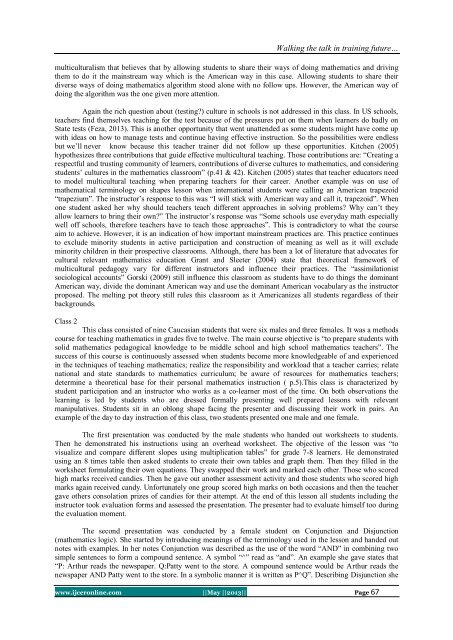Download - ijcer
Download - ijcer
Download - ijcer
You also want an ePaper? Increase the reach of your titles
YUMPU automatically turns print PDFs into web optimized ePapers that Google loves.
Walking the talk in training future…<br />
multiculturalism that believes that by allowing students to share their ways of doing mathematics and driving<br />
them to do it the mainstream way which is the American way in this case. Allowing students to share their<br />
diverse ways of doing mathematics algorithm stood alone with no follow ups. However, the American way of<br />
doing the algorithm was the one given more attention.<br />
Again the rich question about (testing?) culture in schools is not addressed in this class. In US schools,<br />
teachers find themselves teaching for the test because of the pressures put on them when learners do badly on<br />
State tests (Feza, 2013). This is another opportunity that went unattended as some students might have come up<br />
with ideas on how to manage tests and continue having effective instruction. So the possibilities were endless<br />
but we’ll never know because this teacher trainer did not follow up these opportunities. Kitchen (2005)<br />
hypothesizes three contributions that guide effective multicultural teaching. Those contributions are: “Creating a<br />
respectful and trusting community of learners, contributions of diverse cultures to mathematics, and considering<br />
students’ cultures in the mathematics classroom” (p.41 & 42). Kitchen (2005) states that teacher educators need<br />
to model multicultural teaching when preparing teachers for their career. Another example was on use of<br />
mathematical terminology on shapes lesson when international students were calling an American trapezoid<br />
“trapezium”. The instructor’s response to this was “I will stick with American way and call it, trapezoid”. When<br />
one student asked her why should teachers teach different approaches in solving problems? Why can’t they<br />
allow learners to bring their own?” The instructor’s response was “Some schools use everyday math especially<br />
well off schools, therefore teachers have to teach those approaches”. This is contradictory to what the course<br />
aim to achieve. However, it is an indication of how important mainstream practices are. This practice continues<br />
to exclude minority students in active participation and construction of meaning as well as it will exclude<br />
minority children in their prospective classrooms. Although, there has been a lot of literature that advocates for<br />
cultural relevant mathematics education Grant and Sleeter (2004) state that theoretical framework of<br />
multicultural pedagogy vary for different instructors and influence their practices. The “assimilationist<br />
sociological accounts” Gorski (2009) still influence this classroom as students have to do things the dominant<br />
American way, divide the dominant American way and use the dominant American vocabulary as the instructor<br />
proposed. The melting pot theory still rules this classroom as it Americanizes all students regardless of their<br />
backgrounds.<br />
Class 2<br />
This class consisted of nine Caucasian students that were six males and three females. It was a methods<br />
course for teaching mathematics in grades five to twelve. The main course objective is “to prepare students with<br />
solid mathematics pedagogical knowledge to be middle school and high school mathematics teachers”. The<br />
success of this course is continuously assessed when students become more knowledgeable of and experienced<br />
in the techniques of teaching mathematics; realize the responsibility and workload that a teacher carries; relate<br />
national and state standards to mathematics curriculum; be aware of resources for mathematics teachers;<br />
determine a theoretical base for their personal mathematics instruction ( p.5).This class is characterized by<br />
student participation and an instructor who works as a co-learner most of the time. On both observations the<br />
learning is led by students who are dressed formally presenting well prepared lessons with relevant<br />
manipulatives. Students sit in an oblong shape facing the presenter and discussing their work in pairs. An<br />
example of the day to day instruction of this class, two students presented one male and one female.<br />
The first presentation was conducted by the male students who handed out worksheets to students.<br />
Then he demonstrated his instructions using an overhead worksheet. The objective of the lesson was “to<br />
visualize and compare different slopes using multiplication tables” for grade 7-8 learners. He demonstrated<br />
using an 8 times table then asked students to create their own tables and graph them. Then they filled in the<br />
worksheet formulating their own equations. They swapped their work and marked each other. Those who scored<br />
high marks received candies. Then he gave out another assessment activity and those students who scored high<br />
marks again received candy. Unfortunately one group scored high marks on both occasions and then the teacher<br />
gave others consolation prizes of candies for their attempt. At the end of this lesson all students including the<br />
instructor took evaluation forms and assessed the presentation. The presenter had to evaluate himself too during<br />
the evaluation moment.<br />
The second presentation was conducted by a female student on Conjunction and Disjunction<br />
(mathematics logic). She started by introducing meanings of the terminology used in the lesson and handed out<br />
notes with examples. In her notes Conjunction was described as the use of the word “AND” in combining two<br />
simple sentences to form a compound sentence. A symbol “^” read as “and”. An example she gave states that<br />
“P: Arthur reads the newspaper. Q:Patty went to the store. A compound sentence would be Arthur reads the<br />
newspaper AND Patty went to the store. In a symbolic manner it is written as P^Q”. Describing Disjunction she<br />
www.<strong>ijcer</strong>online.com ||May ||2013|| Page 67

















